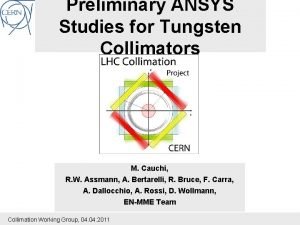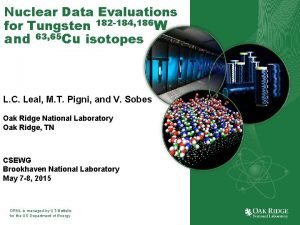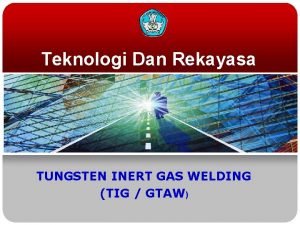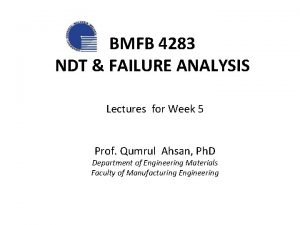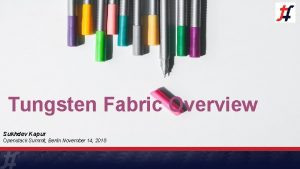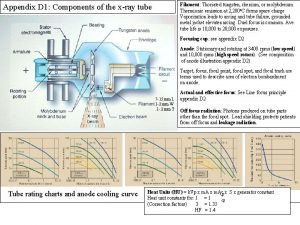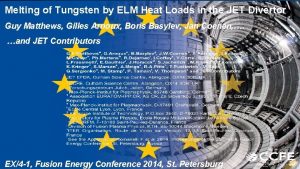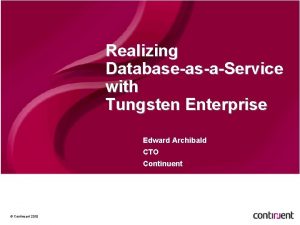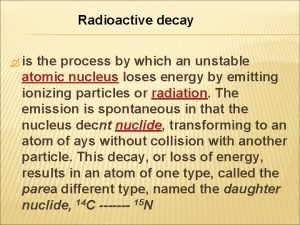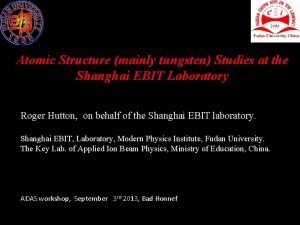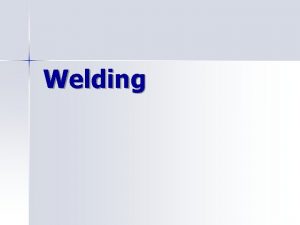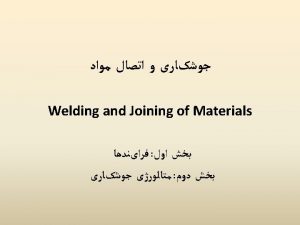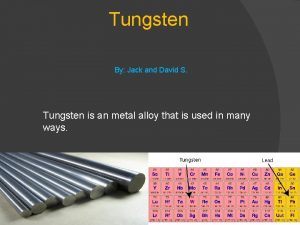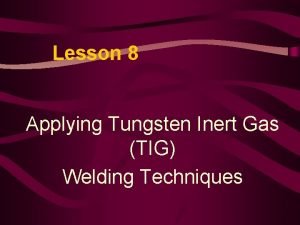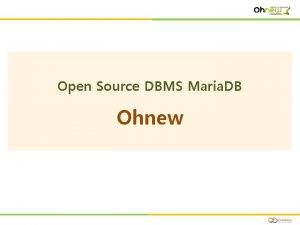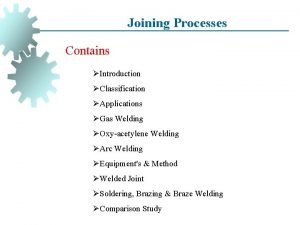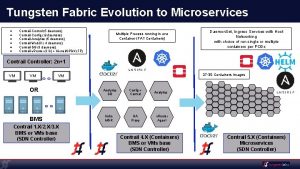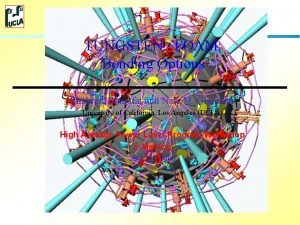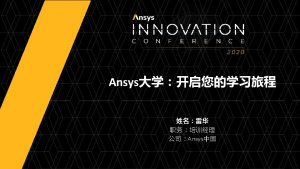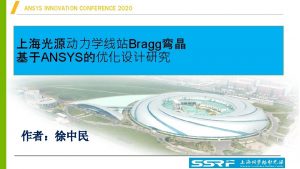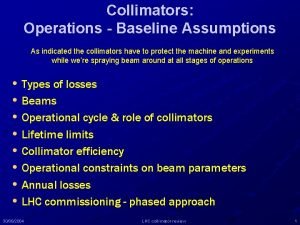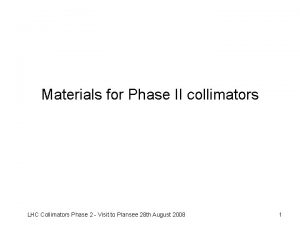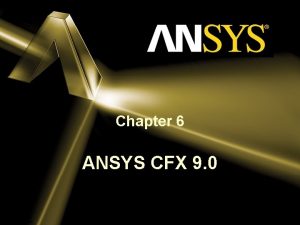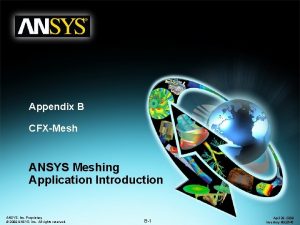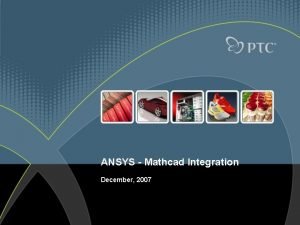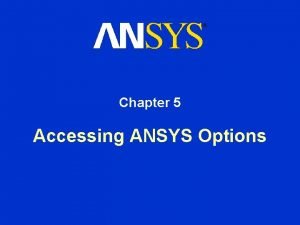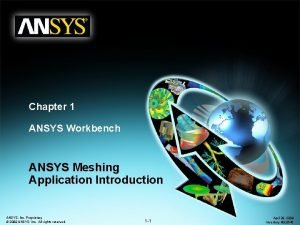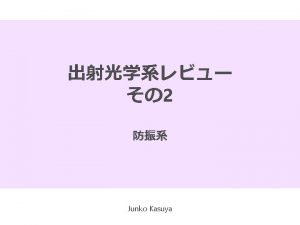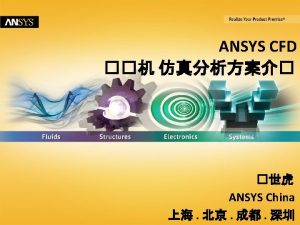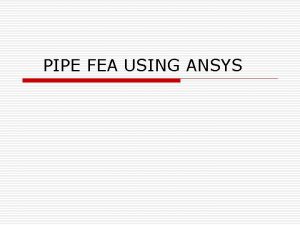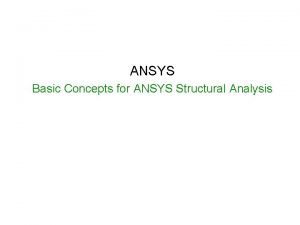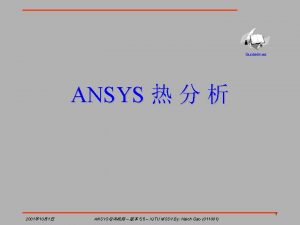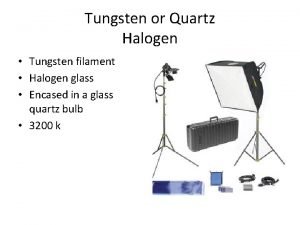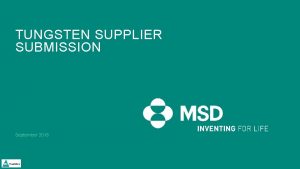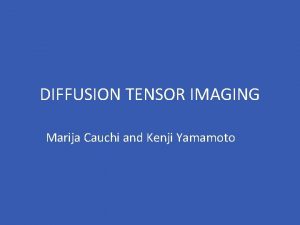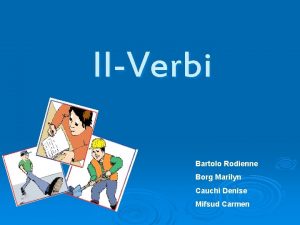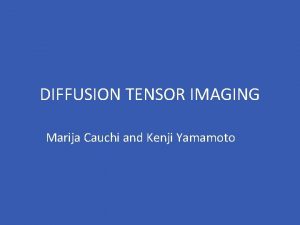Preliminary ANSYS Studies for Tungsten Collimators M Cauchi













![Results 1 ns impact Temperature [o. C] 1 ns impact 25 ns bunch spacing Results 1 ns impact Temperature [o. C] 1 ns impact 25 ns bunch spacing](https://slidetodoc.com/presentation_image/9a9adbd53f5ac78e259ad8ba81a9cc65/image-14.jpg)
![Results Peak Power [MW/m 2] Beam Direction Z-axis [m] – Along the beam direction Results Peak Power [MW/m 2] Beam Direction Z-axis [m] – Along the beam direction](https://slidetodoc.com/presentation_image/9a9adbd53f5ac78e259ad8ba81a9cc65/image-15.jpg)






- Slides: 21

Preliminary ANSYS Studies for Tungsten Collimators M. Cauchi, R. W. Assmann, A. Bertarelli, R. Bruce, F. Carra, A. Dallocchio, A. Rossi, D. Wollmann, EN-MME Team Collimation Working Group, 04. 2011

Acknowledgments • EN-MME department (F. Carra, A. Dallocchio, A. Bertarelli, N. Mariani) for providing the necessary tools (TCT model, material library, etc. ) as well as for weekly training-on-the-job on thermo-mechanical simulations with ANSYS Workbench • FLUKA team (F. Cerutti, V. Boccone EN-STI) for providing several relevant FLUKA input files • H. Richter (DGS/RP) and D. Campanini (EN-MME) for developing and making available FLUKA-ANSYS interface • Collimation team – also F. Burkart, D. Deboy, S. Redaelli, G. Valentino • University of Malta supervisors (P. Mollicone, N. Sammut) Marija Cauchi 2

Outline • Introduction • Simulation Conditions • Flow of Analyses • Finite Element Modelling (ANSYS) § Geometry § Material Properties & Discretization § Loading & Boundary Conditions • Results & Conclusions • Future Work Marija Cauchi 3

Introduction • TCTs – protection of the triplet against quenching & damage • During collimation setup, TCTs are very close to the beam - higher probability of being impacted • High energy & high intensity impacts § Materials involved subject to extreme conditions § Possibility to perform experimental tests is limited § Importance of developing reliable methods & accurate models to estimate the damage induced by an impact • Thermally-induced phenomena up to the melting point of metal can be reasonably well-treated with Standard FEM Codes (ANSYS) Marija Cauchi 4

Simulation Conditions • Different cases derived through variations of energy and no. of impacting bunches • Assuming conservatively that all bunches have the same impact parameter (d=2 mm), same charge (1. 3 x 1011 p) and optical functions at TCTH. 4 R 5 B 2 Case Beam Energy [Te. V] Nominal Beam Emittance Size σx x [μm rad] σy [mm] Impacting Bunches Bunch Spacing [ns] Deposited Energy on Jaw [k. J] TNT Equivalent [g] 1 3. 50 0. 51 x 0. 32 1 - 38. 6 9. 2 2 5 7 0. 60 x 0. 38 1 - 56. 2 13. 4 3 5 7 0. 60 x 0. 38 2 25 111. 3 26. 6 4 5 7 0. 60 x 0. 38 4 25 216. 1 51. 6 • Case 3 and Case 4 were simulated with the same FLUKA input file as Case 2 since effects due to different beam emittances (within a factor of 4) were found to be negligble (A. Bertarelli et al. ) Marija Cauchi 5

Flow of Analyses • Transient thermal analyses performed sequentially § the first transient thermal analysis covers the impact duration of 1 ns § the second transient thermal analysis a time period of 10 s after the impact • Transient structural analysis performed sequentially to thermal analyses • In the case of multi-bunch impact, attachment of multiple transient thermal analyses with the correct times (e. g. impact of 2 bunches: 1 ns, 25 ns, 10 s) Marija Cauchi 6

Finite Element Modelling • Geometry § One TCTH. 4 R 5 B 2 collimator jaw § Symmetrical approach - beam impact on collimator jaw should theoretically lead to a symmetrical energy deposition in the YZ plane (location of symmetry plane indicted by green) Beam Direction Whole collimator structure in Design. Modeler Marija Cauchi Beam Direction Lower symmetrical half of collimator structure in Design. Modeler 7

Finite Element Modelling • Material Properties § Assignment of research-based temperature-dependent material properties (material library) § Jaw material assumed to be pure tungsten (real material: INTERMET 180 – 95% W, 3. 5% Ni, 1. 5% Cu) § Initial simulations excluding presence of screws (assumed to be perfectly bonded) Support Beam (Glidcop Al-15) Block Support (Copper) Stiffener (Glidcop Al-15) Tungsten Block (x 5) (20 x 17 x 200 mm) Water Cooling Pipe (Cu Ni 10 Fe 1 Mn) Marija Cauchi 8

Finite Element Modelling • Finite element discretization § Mesh size for the tungsten blocks: 1 mm (transverse); 5 mm (longitudinal) § Finest mesh close to beam impact (that is mainly on the W jaws) § Mesh density: importance of good compromise between accuracy and computational time Mesh size: 1 x 1 x 5 mm Marija Cauchi 9

FLUKA-ANSYS Interface • Single impact parameters used to generate ANSYS input Marija Cauchi 10

Finite Element Modelling • Loading conditions § Script generated by FLUKA-ANSYS interface inserted as a Command object under Transient Thermal Analysis § Creation of FLUKA plane to deposit energy correctly in accordance with script § Generation of table with energy deposition values and application of heat load • Boundary conditions § Speed of water in cooling pipes = 1. 5 m/s; inner diameter of cooling pipes = 0. 006 m § Water properties (kinematic viscosity, thermal conductivity) § Calculation of Reynolds number and Nusselt number (Dittus-Boelter equation) § Heat convection coefficient on the wet surface of the water pipes, h ≈ 7500 W/m 2 K Marija Cauchi 11

Results • Temperature distribution during beam impact (1 st transient analysis – duration of 1 ns) Tmax = 2465 o. C Beam Direction Marija Cauchi 12

Results Temperature Rise during Impact 4000 • Melting temperature of tungsten = 3370 o. C 3500 • High temperatures reached even with 1 bunch impact at 3. 5 Te. V Temperatue [o. C] 3000 • Similar temperatures to those obtained in AUTODYN (A. Bertarelli et al. ) 2500 2000 5 Te. V - 1 bunch 3. 5 Te. V - 1 bunch 1500 1000 500 0 0 2 E-10 4 E-10 6 E-10 8 E-10 1 E-09 Time [s] Marija Cauchi 13
![Results 1 ns impact Temperature o C 1 ns impact 25 ns bunch spacing Results 1 ns impact Temperature [o. C] 1 ns impact 25 ns bunch spacing](https://slidetodoc.com/presentation_image/9a9adbd53f5ac78e259ad8ba81a9cc65/image-14.jpg)
Results 1 ns impact Temperature [o. C] 1 ns impact 25 ns bunch spacing Insufficient time duration for diffusion to take place Time [s] Marija Cauchi 14
![Results Peak Power MWm 2 Beam Direction Zaxis m Along the beam direction Results Peak Power [MW/m 2] Beam Direction Z-axis [m] – Along the beam direction](https://slidetodoc.com/presentation_image/9a9adbd53f5ac78e259ad8ba81a9cc65/image-15.jpg)
Results Peak Power [MW/m 2] Beam Direction Z-axis [m] – Along the beam direction Marija Cauchi Jaw 1 Jaw 2 Jaw 3 Jaw 4 Jaw 5 15

Results • Temperature distribution after beam impact (2 nd transient analysis – duration of 10 s) Beam Direction • Distribution of deposited energy across structure • Some elements might be gone (eroded zone – not captured by ANSYS) Marija Cauchi 16

Results • Temperatures of structure after 10 s • Differences on going from 3. 5 Tev to 5 Tev • Differences on going from impact of 1 bunch to 2 bunches to 4 bunches Marija Cauchi 17

Results • Structural analysis § Imported body temperature as a body load § Constrained as shown below § Carried out to obtain basis for future steady-state cases § Structural results not reliable since implicit codes (ANSYS) are not appropriate for accident scenarios (high temperatures lead to changes in density and phase which can be correctly simulated with explicit codes (AUTODYN)) Displacement A X = 0, Y = 0, Z = free Rotx = 0, Roty = 0, Rotz = free Displacement B X = 0, Y = free, Z = free Rotx = 0, Roty = 0, Rotz = free Marija Cauchi 18

Conclusions • Purpose of generation of these first basic simulations: to support the future developments through application of correct flow of analyses and usage of tools • High temperatures reached even with 1 impacting bunch at 3. 5 Te. V • Under these conditions, change of density and change of phase (melting) are expected • Comparable thermal results between ANSYS and AUTODYN (any slight differences are due to different interpolation of mesh between FLUKA-ANSYS and FLUKA-AUTODYN) • Use of AUTODYN § Explicit code necessary for accident scenarios (impact conditions) to capture any changes in density and phase (also can simulate very short time durations) § To correctly simulate thermo-mechanical response of the hit material, must take into account both the hyrdodynamic behaviour (through use of a dedicated EOS) and the deviatoric behaviour (using a dedicated material model) Marija Cauchi 19

Future Work • Aim: to evaluate thermo-mechanical behaviour & robustness of TCTs and TCLAs during different beam-impact scenarios § Impact of angles between jaw and beam (beam may not always be parallel to the jaw edge) § Beam energy up to 7 Te. V § Setup accident scenario (1 bunch during collimation setup) § Accident scenario during operation (more unlikely than setup accident scenario because it requires wrong TCT and TCDQ setup and asynchronous dump) § Asymmetrical impact (assume for example 8 mm offset in horizontal jaw due to vertical crossing angle) § Inclusion of shift in impact transverse offset in case of multi-bunch impact scenario § Temperature sensors – simulations to observe how the sensors respond in case of an accident • Also, carrying out of simulations for steady-state conditions for the TCTx Marija Cauchi 20

Questions? Thank you for your attention. Marija Cauchi 21
 Tungsten collimators
Tungsten collimators Paradigm shift from women studies to gender studies
Paradigm shift from women studies to gender studies Tungsten-182
Tungsten-182 Kode warna untuk elektroda tungsten tipe ewla-1 adalah
Kode warna untuk elektroda tungsten tipe ewla-1 adalah Tungsten obeys ohms law because
Tungsten obeys ohms law because Radiation safety
Radiation safety Tungsten invoice portal
Tungsten invoice portal Tungsten fabric openstack
Tungsten fabric openstack Thoriated tungsten filament
Thoriated tungsten filament Tungsten melting pot
Tungsten melting pot Tungsten replicator
Tungsten replicator Tungsten atomic structure
Tungsten atomic structure Tungsten atomic structure
Tungsten atomic structure Welding positions
Welding positions Tig (tungsten inert gas)
Tig (tungsten inert gas) Tungsten streak
Tungsten streak Mariadb mha
Mariadb mha Tig welding definition
Tig welding definition Tungsten replicator
Tungsten replicator Advantages of welding
Advantages of welding Tungsten fabric
Tungsten fabric Tungsten foam
Tungsten foam
